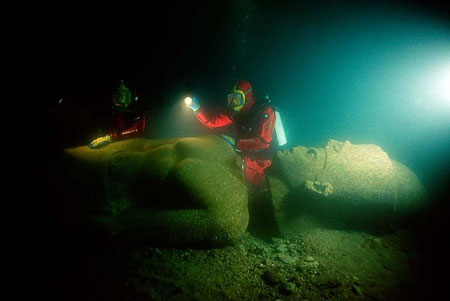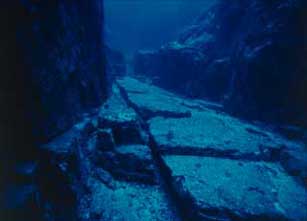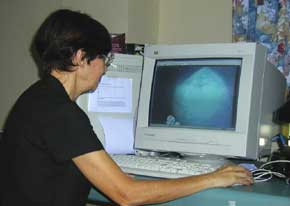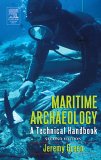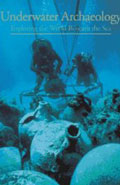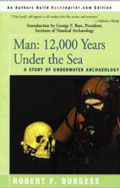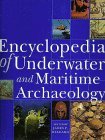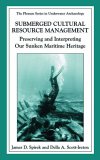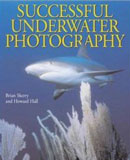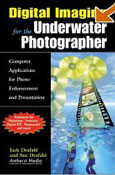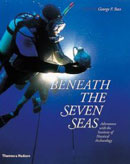|
Right now it’s all on sonar images captured by an underwater robotic vehicle. Archaeologist Quentin Mackie from the University of Victoria (UVIC) and his team returned from a research trip to the Haida Gwaii archipelago in August, where they used an autonomous underwater vehicle (AUV) to scan the sea floor in search of evidence of ancient human inhabitation. His team has been looking for proof of the earliest human presence in North America for decades, and what they think they’ve found is a fishing weir (a man-made rock formation) on the bottom of Juan Perez Sound under 122 meters of water. There are other formations on the sea floor that the team thinks are the sites of ancient camps of the same age. Scientists think that area was at sea level 14,000 years ago and was mostly one large island that stretched across Hecate Strait east toward the mainland. The area has been submerged by 120 meters of water since that last Ice Age.”
Sun Jian, technical director of the Underwater Cultural Heritage Protection Center of the State Administration of Cultural Heritage, said a mildew deterrent and protective spray are being used at the site to prevent damage to the ship and artifacts now that the thick silt layer covering it has been cleared away. The 21.58-meter-long, 9.55-meter-wide vessel that has been named South China Sea (Nanhai) No 1 was salvaged from a depth of 30 meters in the South China Sea in late 2007. Since then, it has been submerged in a sealed pool, called the ‘Crystal Palace’, at the Guangdong Maritime Silk Road Museum on Yangjiang’s Hailing Island.”
Flinders University maritime archaeologist Jonathan Benjamin was part of the team that excavated and recorded the site in October under the leadership of Dr Ehud Galili, a world-renowned expert in submerged prehistory and a senior maritime archaeologist at the Israel Antiques Authority and the University of Haifa. Submerged under five metres of water due to prehistoric sea-level rise, the excavated structure was an important water well that supplied fresh water to the ancient civilisation dated to the pre-pottery Neolithic period that lived on the Kfar Samir site, near Haifa, Israel.”
The more romantic notions involve treasure-hunting amongst shipwrecks. But it was discovered during a survey of the north coast of Egypt at the beginning of the 21st century. One notable underwater archaeologist is Robert Marx, who has written over 60 books on the subject. He was one of the founders of the Council on Underwater Archaeology as well as the Sea Research Society. Marx was also instrumental in creating the professional research degree of Doctor of Marine Histories. For these and more, Marx has earned the description of being ‘The True Father of Underwater Archaeology’, according to noted diving pioneer and magazine publisher, Dr. E. Lee Spence. Marx’s main quest nowadays is a 1715 Spanish shipwreck that occurred off the Florida coast, near what is now Sebastian Inlet. It involved the flagship Capitana, which was then skippered by Don Juan Esteban de Ubilla.”
It’s not quite Atlantis, but the underwater city of Thonis-Heracleion comes very close. For centuries the port was thought to be a legend, after disappearing beneath the Mediterranean around 1,200 years ago.
But it was discovered during a survey of the north coast of Egypt at the beginning of the 21st century. Ever since, researchers have slowly been discovering more and more about the city, through which all trade from Greece and the Mediterranean entered Egypt. Archaeologists have found the wreckages of more than 64 ships, gold coins and giant 16-foot statues. Slabs of stone inscribed in both ancient Greek and Ancient Egyptian have also been brought to the surface.”
Dubbed by the Greek media ‘a small underwater Pompeii’, the structures lay at a depth of just 6 feet on the northeastern coast of Delos. ‘In the past these ruins were identified as port facilities’, the culture ministry said. But a new investigation by the National Hellenic Research Foundation and the Ephorate of Undersea Archaeology, led to different conclusions. Rather than a dock, a pottery workshop and other buildings once stood at the site. Archaeologists found 16 terracotta pots and remains of a kiln embedded in the sea floor.”
The divers, who discovered the ancient shipwreck, were highly-trained and work with Global Underwater Explorers, a Florida-based group. They are helping the Italian researchers to know more about an ancient shipwreck, which apparently happened at the time of second Punic Wars between Carthage and Rome. They aid the archaeologists by swimming about the wreck and fetching the artifacts. This time, the divers swam past large amphora (terra cotta jars ), which were used for carrying wine, olive oil and other things on the Mediterranean trade route thousands of years ago.”
A new field calls itself Continental Shelf Prehistoric Research and it studies the remains of prehistoric human settlements which are now submerged beneath coastal waters. Some of the now-drowned sites are tens of thousands of years old, requiring archaeologists to get help from oceanography and the geosciences. A recent paper describes how during the successive ice ages of the last million years, the sea level dropped at times by up to 120 meters and the exposed area of the continental shelf added 40% to the land area of Europe; a terrain occupied by vegetation, fauna, and people. Consequently, many of the remains and artifacts of Europe’s prehistory are now underwater. Pre-humans inhabited the Black Sea coast 1.8 million years ago, the coast of northern Spain over 1 million years ago and the coast of Britain at least 800,000 years ago, the now-drowned land includes some of the earliest routes from Africa into Europe, and the areas where people survived during the multiple Ice Ages.”
Two thousand years ago, a Greek mechanic set out to build a machine that would model the workings of the known Universe. The result was a complex clockwork mechanism that displayed the motions of the Sun, Moon and planets on precisely marked dials. By turning a handle, the creator could watch his tiny celestial bodies trace their undulating paths through the sky. The mechanic’s name is now lost. But his machine, dubbed the Antikythera mechanism, is by far the most technologically sophisticated artefact that survives from antiquity. Since a reconstruction of the device hit the headlines in 2006, it has revolutionized ideas about the technology of the ancient world, and has captured the public imagination as the apparent pinnacle of Greek scientific achievement. The remains of the Antikythera mechanism were salvaged from a shipwreck in 1901 (see ‘Celestial mirror from the deep’) and are now held in the National Archaeological Museum in Athens.”
After a survey and diving tour in Binh Chau near Quang Ngai province in central Vietnam, international experts have praised the area as unique because of its many mysterious ancient sunken ships. The Antikythera wreck was first discovered in 1900 by sponge divers who were blown off course by a storm. At the age of 80, underwater archeologist Borje Rorssell (Sweden) did not hesitate to wear diving clothes and scuba to explore the waters of Binh Chau. After two hours of diving to see wrecks there, Rorssell said the shipwrecks contained many ceramic antiquities with beautiful patterns. Introducing this ‘graveyard of ancient ships’ to international friends, Vietnamese underwater cultural heritage expert – Nguyen Tuan Lam – said scientists surveyed an area within a radius of 10 km2 in the Strait of Vung Tau of Binh Chau Commune. They discovered 10 ancient sunken ships.”
The high-tech ‘Exosuit’ is being used to explore the Antikythera shipwreck, and has allowed them to dive to more than double the depths of previous expeditions. It was on this location that the so-called Antikythera Mechanism – a 2nd-century BC device dubbed the world’s oldest computer – was discovered by sponge divers in 1900 off the remote Greek island. The highly complex mechanism, consisting of up to 40 bronze cogs and gears, was used by the ancient Greeks to track the cycles of the solar system. It was so advanced, it took another 1,500 years for an astrological clock of similar sophistication to be made in Europe.”
Even more incredible images and further details can be found on the Return to Antikythera Blog ‘Archive for October 2014 ‘ and is well worth bookmarking – Ed.]
The rescued antiquities include tableware, ship components, and a giant bronze spear that would have belonged to a life-sized warrior statue. The Antikythera wreck was first discovered in 1900 by sponge divers who were blown off course by a storm. They subsequently recovered a spectacular haul of ancient treasure including bronze and marble statues, jewellery, furniture, luxury glassware, and the surprisingly complex Antikythera Mechanism. But they were forced to end their mission at the 55-meter-deep site after one diver died of the bends and two were paralyzed. Ever since, archaeologists have wondered if more treasure remains buried beneath the sea bed.”
A specialist group of European researchers are studying the remains of prehistoric human settlements which are now submerged beneath our coastal seas. Some of these drowned sites are tens of thousands of years old. From the progressive discovery and analysis of these prehistoric remains, a new scientific field has emerged, combining the expertise from many disciplines including archaeology, oceanography and the geosciences. The new field is called Continental Shelf Prehistoric Research.” The continental shelf off the European coast, known as The Celtic Shelf, saw political interference preventing exploration for many years as European countries tried to hide discovery of their “listening devices” planted during the Cold War period. You can download The EMB position paper ‘Land Beneath The Waves’ in .pdf – Ed.]
The discovery was announced Oct. 2 by archeologists with the University of the Ryukyus and the Matsuura city board of education who are researching the Takashima Kozaki underwater historic site. Numerous artifacts have been recovered from the seabed from wrecks of fleets dispatched in 1274 and 1281 to invade Japan. In both invasion attempts, battles were fought in northern Kyushu. The fleet of 4,400 vessels sent by Kublai Khan in 1281 was wrecked near Takashima island in a storm the Japanese dubbed ‘kamikaze’ (divine wind) for ultimately saving their homeland from the Mongols.”
During the weekend of September 20 the autonomous underwater vehicles made 40 long passes over the area that is home to the most famous of all ancient wrecks, the Antikythera ‘treasure ship’, taking its picture in detail for the first time. Researchers are now processing the data from about 50,000 photos to create a three-dimensional photo map of the site. Even though the wreck has been visited before, this is the first mapping of it and one of only a handful of 3D maps of ancient underwater sites ever developed. The large, loaded vessel was caught in a storm some time around 70 B.C. and it crashed into a sheer rock wall along the island of Antikythera and sank. The ship carried a huge array of precious objects-the richest cache ever found in the Mediterranean-from life-sized bronze and marble statues to gem-encrusted gold jewelry, coins and the only example of an ancient analog computer, now called the ‘Antikythera mechanism.'”
It’s not Atlantis they’re after, but possible 13,000 year old settlements off the coast of Haida Gwaii that would have been lush grassland before the end of the last ice age caused sea levels to rise as much as 150 metres. The copper ingots led the youth to go to the curator of the local museum. After an incredibly successful 10-day research trip that saw researchers use a $1.5 million Bluefin automated underwater vehicle to survey 100 linear kilometers of ancient riverbeds, archaeologist Quentin Mackie believes his team is on the verge of a historical breakthrough. ‘We’ve known that sea levels were much lower towards the end of the ice age, so we decided to try to find archaeological sites and evidence of people on the sea floor’, explained Mackie. ‘I had this idea that if people were using fish traps and weirs along the river, we could target the area for those items.'”
In 1983 the ship was accidentally discovered by a 13-year-old diving for sponges near the Turkish fishing town of Kas. The copper ingots led the youth to go to the curator of the local museum. The shipwreck was dug up by an excavation expedition of underwater archaeologists, first under the leadership of Professor George Bass and later under Professor Cemal Pulak, both from the Institute of Nautical Archaeology at Texas A&M University. Excavating and documenting the 10,000 items found on the ship was a 10-year project. The late Bronze Age shipwreck, known as the Uluburun Shipwreck, is seen as one of the most important underwater discoveries of the second half of the 20th century.”
Professor Hayat Erkanal, the head of Limantepe excavations for the underwater ancient city of Klozemenai and director of ANKUSAM, said the port dates back to the seventh century BC. Klozemenai, he explained, was a coastal town, making it the home of many sunken ships from different eras. An earthquake in the eighth century left the city underwater. He said the team is currently working to determine the features and correct age of its most recent shipwreck find.”
Yang Junxi, an 11-year-old boy, discovered upon the rusty sword on July 2 when he was playing near the Laozhoulin River in Linze Township of Gaoyou County, according to the Gaoyou Cultural Relics Bureau. While washing hands in the river, Yang touched the tip of something hard and fished out the metal sword. He took it home and gave it to his father Yang Jinhai. Upon hearing the news, people began flocking to Yang’s home, the father said. ‘Some people even offered high prices to buy the the sword, but I felt it would be illegal to sell the cultural relic’, Yang said. After considering his options, the father sent the sword to the Gaoyou Cultural Relics Bureau on Sept. 3. Initial identifications found the 26 cm-long yellow-brown sword could be dated back to more than 3,000 years ago, around the time of the Shang and Zhou dynasties, said Lyu Zhiwei, head of the cultural relics office of the bureau.”
A recent excavation uncovered a ship estimated to date back 4,000 years, which experts say would make it the oldest sunken ship to have been discovered in the Mediterranean. Urla Port is one of Turkey’s rare underwater excavation sites. Professor Hayat Erkanal, the head of Limantepe excavations for the underwater ancient city of Klozemenai and director of ANKÜSAM, said the port dates back to the seventh century B.C. Klozemenai, he explained, was a coastal town, making it the home of many sunken ships from different eras. An earthquake in the eighth century left the city underwater.”
The ancient six to seven metre long vessel is estimated to be 6,500 years old – in comparison, the oldest Pyramid in Egypt is a mere 4,500 years old – and although it is damaged, archaeologists are finding it very interesting. ‘It split 6,500 years ago and they tried to fix the crack by putting a bark strip over it and drilling holes both sides of it’, Jørgen Dencker, the head of marine archaeology at the Viking Ship Museum in Roskilde, told DR Nyheder. ‘That two-millimetre wide strip has been preserved.'”
One of the oldest shipwrecks found in the Mediterranean, the vessel is about 50 feet long. It was found at a depth of 400 feet on the sandy seabed of Gozo island, the second-largest island in the Maltese archipelago. ‘There are very good chances that the wooden hull is still present, buried beneath the sand’, Timmy Gambin, a senior lecturer in maritime archaeology at the University of Malta and the co-director of the project, told Discovery News.”
‘During the expedition, which is led by Professor Vladimir Ploskikh from the Kyrgyz Academy of Sciences, Kyrgyz and Russian scientists plan to explore underwater archaeological sites to test the hypothesis of the ancient, so-called Andronovo culture, located in the area that is now flooded by the waters of Issyk Kul’, Lukashov said. According to Lukashov, underwater archeologists are to continue their studies of a settlement that was discovered at the bottom of the lake during the last expedition. Radiocarbon dating has shown the flooded settlement existed for over 3,000 years.”
University of Malta researcher Timothy Gambin said Monday the 20 grinding stones and 50 amphorae from the ship date back to around 700 B.C. Experts hope to find parts of the ship and other artifacts beneath the sandy seabed 1 mile (1. 6 kilometers) off Gozo island. They say the ship probably was sailing between Sicily and Malta when it sank.”
The two relics, which were pulled up together, may come from a place that hasn’t been dry land since 14,000 years ago. If so, the combination of the finds may suggest that people lived in North America, and possibly butchered the mastodon, thousands of years before people from the Clovis culture, who are widely thought to be the first settlers of North America and the ancestors of all living Native Americans. But that hypothesis is controversial, with one expert saying the finds are too far removed from their original setting to draw any conclusions from them. That’s because the bones were found in a setting that makes it tricky for scientists to say with certainty where they originated and how they are related to one another.”
Delivering a lecture here at the Samskrithi Bhavan organised under the aegis of the Bharateeya Vichara Kendram, he said archaeological discoveries in recent months include Chinese coins, celadon wares of the Chinese, Roman pottery, Arab coins and Lower Palaeolithic tools from below the seabed at Thangassery in Kollam district. Stone Age Petroglyphs in the form of cupules at Mattidampara in Kadakkal rock-shelter of Kollam district and the same type of cupules at Piralimattam caves in Ernakulam district; Chinese coins from Sasthamcottah lake in the Kallada river basin, and the latest is the Neolithic stone axe having Brahmi scripts from Kalady in Ernakulam district.”
‘This is one of our best ones’, said the geoarcheaologist at the University of Michigan. ‘What’s cool about this is you can actually see where it’s been split off from the rock.’ To Dr. Sonnenburg and her colleagues, the fragment bears the mark of a human maker. What makes that interesting – and controversial – is that the flake was scooped up last summer from a layer of 9,000-year-old sediment at the bottom of Lake Huron. The group contends it is one of many signs that point to the existence of a submerged hunting complex that is more than twice as old as Stonehenge and the Great Pyramids of Egypt.”
The Swiss-Greek project starts next week and archaeologists hope it will shed new light on how the first farming communities spread through the continent. Working near a major prehistoric site, they will investigate a bay aptly called Kiladha – Greek for valley. The area was once dry land and archaeologists operating off the MS Turanor PlanetSolar hope it may contain sunken remains of buildings from Neolithic times, when farming started, about 9,000 years ago.”
‘The largest museum of the world is in the Greek sea. There are more than 1,500 shipwrecks down there and their research will help us understand more about our origins’, Greek Minister of Culture, Konstantinos Tassoulas said along with the scientific crew of the 31-meters- long catamaran during a press conference. The vessel arrived in Greece to explore one of Europe’s oldest human settlements off the Franchthi cave in the Argolic Gulf, in the southeast of Peloponnese. “
Divers Iulian Rusu and Pascale Roibu found the remains of an ancient ship in the antic harbor area in seaside city Constanta, at a depth of 17 meters, according to Digi24 TV station.”
The underwater archaeological work of the sunken ship was launched in 2012. Its excavated relics include blue and white porcelain wares, five-colored porcelains, purple clay teapots, jade seals and Spanish silver coins. The Xiaobaijiao-1 is an ancient merchant wooden vessel which sank nearly two centuries ago off the coast of east China’s Zhejiang province.”
Shipwrecks around Shanhu and Jinyin islands in the Xisha archipelago will be excavated over the next two years, Wang Yiping, head of cultural heritage for Hainan Province, told Xinhua. Stone building material and carvings dating back to the Qing Dynasty (1644-1911) have been discovered at the sites. The material may have been carried by unfortunate Chinese emigrants whose ships sank. Such immigrants are known to have constructed traditional Chinese homes and temples at their destinations in Southeast Asia.”
The exhibition on the wreck that went down in the second quarter of the 1st century BC – taking with it artworks, coins and other artifacts, along with the world’s oldest known analog computer, the ‘Antikythera mechanism’ – was so successful that it prompted scientists and archaeologists to revisit the location where the shipwreck had been discovered, just off the coast of Antikythera in the southern Aegean. An event was recently organized to mark the closing of the exhibition in Athens, before it travels to Switzerland, where it will go on display in 2015. During the event, a large-scale expedition to the shipwreck was announced, which will run for a month from September 15, bringing together Greek and international experts. With the aid of new technology, the archaeologists and scientists will dive down to the shipwreck, where they are expected to make great new discoveries.”
The researchers suggest that this succession of destructive waves up to 14 metres high may have depopulated an area that is now in the middle of the North Sea, known as Doggerland. However, melting ice at the end of the last ice age around 18,000 years ago led to rising sea levels that inundated vast areas of continental shelves around the world. These landscapes, which had been home to populations of hunter gatherers for thousands of years were gradually overwhelmed by millions of tonnes of meltwater swelling the ocean. Doggerland, essentially an entire prehistoric European country, disappeared beneath the North Sea, its physical remains preserved beneath the marine silts but lost to memory. Although effectively untouched and largely untouchable, the existence of these landscapes had been appreciated since the 19th century. Their potential significance was such that the archaeologist Graham Clark, father of British Mesolithic studies, wrote in 1936 that: ‘It would be possible to take comfort from the fact that such cultures might not have existed, were it not eminently probable that they not only existed, but flourished, under conditions more favourable than those inland.'”
A wooden notebook, which was found in a sunken ship, the replica of which will sail, is considered the Byzantine’s invention akin to the likes of the modern-day tablet computer. During archaeological excavations, experts have also found striking information on animal culture, such as the meat of many animals, like horses and wild donkeys were eaten in the ancient era. Remains unearthed in the excavations drew great attention not only in Turkish, but also in world archaeology. The remains have survived as organic products, which greatly impressed the scientific world. Speaking about the remains, the project team member Associate Professor Ufuk Kocabas said they had found organic products in Yenikapi area, which was known as Theodosius Port in Byzantine, a rare discovery. He said 60 percent of the sunken ship had survived in a preserved condition.”
In 1857, during the dwindling years of the California Gold Rush, a steamship loaded with some 30,000 pounds (13,600 kilograms) of gold was ensnared in a hurricane and sunk off the coast of South Carolina, banishing gold bars and freshly minted coins to the bottom of the sea. Last month, during a reconnaissance expedition to the wreckage of the so-called “Ship of Gold,” more than 60 lbs. (27 kg) of the lost treasure was recovered. Odyssey Marine Exploration Inc., a company that specializes in deep-ocean exploration, retrieved five gold bars and two gold coins — one from 1850 that was minted in Philadelphia, and the other from 1857 that was minted in San Francisco — from the sunken ship known as the SS Central America.”
This was just the latest discovery made as part of the Gulf of Mexico expedition by NOAA Ship Okeanos Explorer. The expedition heads to investigate another potential shipwreck site on Thursday, April 24. The public is invited to view live video from the Gulf. ‘These sites never fail to amaze as to the preservation of the artifacts and what we continue to find intact on the sites’, said Meadows Center underwater archaeologist Fritz Hanselmann. ‘Artifacts such as this chronometer serve as a tangible connection to our past and shed light on aspects of history that are unknown.'”
Known as the submerged Alpena-Amberley Ridge (AAR), it provided a dry land bridge between Michigan and Ontario 9,000 years ago. Using sonar surveys, investigation by a remotely operated vehicle (ROV), and scuba-equipped underwater archaeologists, team leader John O’Shea of the Museum of Anthropological Archaeology, University of Michigan, and colleagues identified ancient human-made structures on the ridge, structures that they suggest were likely used for caribou hunting. One such site, called the Drop 45 Drive Lane, consists of two parallel rock-lined paths, suggested by the researchers to have been used to funnel caribou into an 8-meter-wide lane. They also identified what they call V-shaped hunting blinds set above the lane on a hill. Scuba-trained archaeologists recovered eleven flakes of chert, typical by-products of stone tool repair or maintenance. Scientists have long theorized that Paleoindian and archaic indian hunters pursued and entrapped their prey by using cooperative, organized techniques, requiring a sophisticated level of social interaction and planning.”
There was hope in a Canadian Forces release today, when the Harper government triumphantly announced new images captured of the Breadalbane, one of the sunken ships originally tasked with finding survivors of Franklin’s voyage – which makes it one of the only substantial artifacts linking Canada with the lost Franklin expedition. ‘Personnel deployed on Operation NUNALIVUT 2014 have captured exciting new footage of the sunken merchant ship Breadalbane, a National Historic Site of Canada’, reads the emailed release. Funny thing is this isn’t new: The sunken Breadalbane, a merchant supply ship originally sunk in 1853,was already discovered completely intact in 1983. But that didn’t stop Canada’s Environment Minister Leona Aglukkaq, herself a native of Nunavut, from overselling the mission as a public triumph. ‘Our government is committed to protecting Canada’s rich natural heritage and historic sites’, she said. In fact, I’ve personally seen Franklin expedition related artifacts in glass displays outside of the prime minister’s office in Ottawa. The symbolism isn’t lost: Harper wants the Arctic. Finding Franklin’s ships, the HMS Erebus and Terror, will help establish for his relatively young country the historical chops to compete with Russia’s own aggressive claim over disputed and potentially resource-rich Arctic land. Of course, Canada didn’t exist at the time of Franklin’s journey, and any actual historical link with the voyage is tenuous.”
‘These wrecks are time capsules of history as they have carried with them the technology, material culture, and objects from their current time, place, and culture of origin’, said Reginald Murphy, Secretary-General of the Antigua and Barbuda National Commission for UNESCO, during a side event Tuesday to discuss the potentials, preservation and use of Underwater Cultural Heritage in SIDS. The Atlantic slave trade that brought slaves from Africa to the Americas during the 16th to 19th century, for example, has left an abundance of underwater remnants ideal for research, education and development. Anyone of African decent living on Turks and Caicos Islands (islands located 550 miles southeast of Miami, Florida) can trace their ancestry to the 193 slaves who survived the wreck of the slave ship “Trouvadore” in 1841, according to Murphy. “
In the 1970s and 1980s, Fischer and Anderson recovered some of the most well preserved material ever seen from sites such as the 6,500-year-old settlement at Tybrind Vig. This was the first submerged settlement excavated in Denmark and from 1977 was the scene of intensive archaeological activity. Lying 300m from the present shoreline and beneath 3 metres of water, divers excavated sensationally well-preserved artefacts from the Ertebølle Culture. This included dugout boats and decorated wooden paddles, and gave unprecedented insight into the everyday lives of the prehistoric societies of Northern Europe.”
Such tales suggest that catastrophic flooding is nothing new for the coastal communities of Britain. In fact diluvian myths abound in cultures across the world: the 700BC Epic of Gilgamesh, Babylonian accounts of a Great Flood, Manu’s building of the great boat in Hindu mythology, Zeus’ punishment of humanity using a great flood, and of course the tale of Noah from the Bible – all these indicate the widespread effects of rapid sea level change.”
It is the oldest wrecked ship of twelve that were identified along 200km off the windswept Tierra del Fuego coast. The ship, “La Purisima Concepcion”, went down January 10, 1765 off the Mitre peninsula – about 3,500km south of Buenos Aires – as it headed for the turbulent Cape Horn after sailing from Cadiz and stopping in Montevideo.”
The forest of Borth once stretched for miles on boggy land between Borth and Ynyslas, before climate change and rising sea levels buried it under layers of peat, sand and saltwater. The skeletal trees are said to have given rise to the local legend of a lost kingdom, Cantre’r Gwaelod, drowned beneath the waves. The trees stopped growing between 4,500 and 6,000 years ago, as the water level rose and a thick blanket of peat formed.”
Experts made their first diving into to the remains of a nearly 1,600 year-old basilica, which was recently discovered under Lake ?znik during a photo shoot from the air. The early Byzantine era basilica, which has the traces of early Christianity architecture, was found about 20 meters from the shore. A professional diving team, which arrived in the northwestern province of Bursa’s ?znik district upon the invitation of the Bursa Municipality, along with a team from the Anatolia Agency, scanned the basilica in details. Experts in the diving team made technical observations and measurement in the main body of the basilica. The team, which was also accompanied by the archaeologists of the ?znik Museum Directorate, remained under water for some 2.5 hours. The rite room and naves, which separate the structure into three main parts, were closely monitored and photographed.”
Word of the remarkable find has caught the imagination of the world of archaeology, but the police cannot say when the life-sized bronze might re-emerge or where it might be put on display. A local fisherman says he scooped the 500-kg god from the sea bed last August, and carried it home on a donkey cart, unaware of the significance of his catch. Others soon guessed at its importance, and the statue briefly appeared on Ebay with a $500,000 price tag – well below its true value. Police from the Islamist group Hamas, who rule the isolated Palestinian territory, swiftly seized it and say they are investigating the affair. To their great frustration, archaeologists have not been able to get their hands on the Apollo, and instead must pore over a few blurred photographs of the intact deity, who is laid out incongruously on a blanket emblazoned with Smurfs. From what they can tell it was cast sometime between the 5th and the 1st century BC, making it at least 2,000 years old.”
The sunken ship has been sitting on the seafloor off the southern coast of Sri Lanka for some 2,000 years and was discovered in 2003. The shipwreck lies 33 metres below the ocean’s surface, just off the fishing village of Godavaya where German archaeologists in the 1990s had discovered a harbour that was an important port along the maritime Silk Road during the second century AD. ‘Everything is pretty broken but the wreck could fill a gap in the existing evidence for the trade that brought metals and exotic commodities like silk from Asia to the Roman world’, Deborah Carlson, president of the institute of nautical archaeology at Texas A&M University, was quoted as saying.”
The remains of the big structure were found by pure chance a few months ago thanks to pictures taken to promote tourism in the area. The silhouette of the ancient building was detected underwater and a team of archaeologists from the University Uludag in Bursa led by Mustafa Sahin started investigating. ‘Excavation’ work found the remains of a basilica probably built around the IV century AD.”
‘We have found church remains. It is in a basilica plan and has three naves’, said Mustafa Sahin, an archaeology professor at Bursa Uluda? University. The foundations of the church are currently lying in water that is about 1.5 to two meters deep. ‘This church’s remains are similar to the Hagia Sophia in Iznik. This is why we estimated that it was built in the fifth century A.D.’, said Sahin.”
Archaeologists believe the relics were left by Swedish nomads 11,000 years ago and the discovery may be evidence of one of the oldest settlements ever found in the Nordic region. Some of the relics are so well preserved, reports have dubbed the find ‘Sweden’s Atlantis’ and suggested the settlement may have been swallowed whole by the sea in the same way as the mythical island in the Atlantic Ocean. The artefacts were discovered by Professor Bjorn Nilsson from Soderton University, and a team from Lunds University, during an archaeological dive at Hano, off the coast of Skane County in Sweden. Buried 16 metres below the surface, Nilsson uncovered wood, flint tools, animal horns and ropes.”
The remains of the 2,930-metre-long bridge, made entirely of granite and dating back nearly 400 years, appeared at Poyang lake in the central province of Jiangxi, the Beijing News reported. The lake, which has been as large as 4,500 square kilometres in the past, has been drying up in recent years due to a combination of low rainfall and the impact of the Three Gorges Dam, experts say.” |
…
…
|
